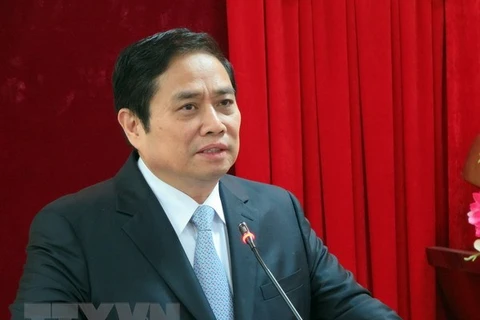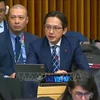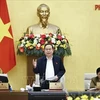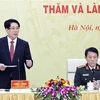 The seventh plenary meeting of the 12th-tenure Party Central Committee opens in Hanoi on May 7 (Photo: VNA)
The seventh plenary meeting of the 12th-tenure Party Central Committee opens in Hanoi on May 7 (Photo: VNA) Hanoi (VNA) – The strategy on cadres in the period of national industrialisation and modernisation enhancement, issued by the 8th-tenure Party Central Committee in 1997, has fulfilled its “historic mission”, creating an institutional framework for the shaping and development of the cadre contingent in the country’s new development period.
Politburo member Pham Minh Chinh, Secretary of the Party Central Committee and Chairman of the Party Central Committee’s Organisation Commission, made the comment in an article ahead of the seventh plenary meeting of 12th-tenure Party Central Committee.
The cadre strategy was issued in Resolution 03/NQ-TW of the third plenary meeting of the eighth-tenure Party Central Committee dated June 18, 1997 with a view to creating fundamental and comprehensive improvement of the contingent of cadres.
Looking back on the past two decades, aside from certain shortcomings, the implementation of the cadre strategy has resulted in important outcomes, Chinh said.
In terms of institutional building, the Politburo and the Party Central Committee Secretariat from the 8th to the 12th tenures have issued 142 documents, including seven thematic resolutions. Since the beginning of the 12th tenure alone, 26 documents on personnel work rectification have been promulgated.
As a result, the contingent of cadres at all levels has developed in multiple aspects while their quality has been increasingly improved. The age, gender, ethnicity and profession structures of cadres have become more balanced.
According to the article, the rate of under-40 officials holding leadership and management positions is 6.22 percent at central-level agencies and ministries and 6.41 percent at the provincial level. The rate of those under 35 years old at the district level is 6.5 percent. The ratio of female cadres holding positions under the management of the Party Central Committee, the Politburo and the Party Central Committee Secretariat has doubled over the last three tenures, from 10 percent to 20 percent. About 13.03 percent of officials holding senior positions at central agencies and ministries are women.
Chinh also highlighted improvements in the evaluation, planning, training, election, appointment and rotation of cadres, which have been made in an increasingly democratic, objective, open and transparent manner.
He added for the first time, the 11th-tenure Party Central Committee introduced several new measures with the aim of enhancing the quality of officials holding leading and managerial positions at all levels, including making a personnel plan for the Party Central Committee, organising votes of confidence on officials at Party and people-elected agencies, filling all positions of the State leadership immediately after the National Party Congress, and organising training courses for potential candidates for high-level positions.
The Party’s examination and inspection work has received greater attention and been stepped up, he wrote, noting that many violations have been uncovered and publicised, thereby giving warning and deterrence against negative phenomena and consolidating officials, Party members and people’s trust in the Party and the State.
In his article, Chinh affirmed that the development of the contingent of cadres in general and those in the leadership and management at all levels in particular, has considerably contributed to the huge and historic achievements of the country’s Doi moi (renewal) in the past over 30 years.
The maturity and development of the cadre contingent over the last two decades are vivid evidence of the significance and values of the cadre strategy. It’s now an occasion for the Party to reflect on the successes that need to be promoted and the shortcomings that need to be addressed so as to draw useful lessons serving the continued building of the cadre contingent and reform of personnel work, to meet requirements of new tasks in the new revolutionary period, the official added.-VNA
VNA
























